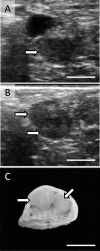Accessory corpora lutea formation in pregnant Hokkaido sika deer (Cervus nippon yesoensis) investigated by examination of ovarian dynamics and steroid hormone concentrations
- PMID: 25482110
- PMCID: PMC4353723
- DOI: 10.1262/jrd.2014-076
Accessory corpora lutea formation in pregnant Hokkaido sika deer (Cervus nippon yesoensis) investigated by examination of ovarian dynamics and steroid hormone concentrations
Abstract
Generally, sika deer conceive a single fetus, but approximately 80% of pregnant females have two corpora lutea (CLs). The function of the accessory CL (ACL) is unknown; moreover, the process of ACL formation is unclear, and understanding this is necessary to know its role. To elucidate the process of ACL formation, the ovarian dynamics of six adult Hokkaido sika deer females were examined ultrasonographically together with peripheral estradiol-17β and progesterone concentrations. ACLs formed in three females that conceived at the first estrus of the breeding season, but not in those females that conceived at the second estrus. After copulation, postconception ovulation of the dominant follicle of the first wave is induced by an increase in estradiol-17β, which leads to formation of an ACL. A relatively low concentration of progesterone after the first estrus of the breeding season is considered to be responsible for the increase in estradiol-17β after copulation.
Figures


Similar articles
-
Serum hormone concentrations and ovarian follicular wave emergence in Jilin sika deer (Cervus nippon hortulorum) after synchronization of estrous cycles.Anim Reprod Sci. 2015 Feb;153:44-9. doi: 10.1016/j.anireprosci.2014.11.017. Epub 2014 Dec 27. Anim Reprod Sci. 2015. PMID: 25563157 Clinical Trial.
-
Immunohistochemical localization of steroidogenic enzymes in corpus luteum of wild sika deer during early mating season.Jpn J Vet Res. 2004 Feb;51(3-4):167-72. Jpn J Vet Res. 2004. PMID: 15070042
-
Reproduction of female Sika deer (Cervus nippon yesoensis Heude, 1884) in Ashoro District, Hokkaido.J Vet Med Sci. 1993 Oct;55(5):833-6. doi: 10.1292/jvms.55.833. J Vet Med Sci. 1993. PMID: 8286539
-
Histological difference between retrograde corpora lutea of pregnancy and those of estrus in sika deer, Cervus nippon.J Vet Med Sci. 1994 Apr;56(2):309-14. doi: 10.1292/jvms.56.309. J Vet Med Sci. 1994. PMID: 7521218
-
Genetic merit for fertility traits in Holstein cows: II. Ovarian follicular and corpus luteum dynamics, reproductive hormones, and estrus behavior.J Dairy Sci. 2012 Jul;95(7):3698-710. doi: 10.3168/jds.2011-4976. J Dairy Sci. 2012. PMID: 22720927
Cited by
-
Effects of heat stress on the endometrial epidermal growth factor profile and fertility in dairy cows.J Reprod Dev. 2022 Apr 1;68(2):144-151. doi: 10.1262/jrd.2021-120. Epub 2022 Jan 28. J Reprod Dev. 2022. PMID: 35095040 Free PMC article.
-
Effect of bone morphogenetic protein-4 on in vitro growth, steroidogenesis and subsequent developmental competence of the oocyte-granulosa cell complex derived from bovine early antral follicles.Reprod Biol Endocrinol. 2016 Jan 15;14:3. doi: 10.1186/s12958-016-0137-1. Reprod Biol Endocrinol. 2016. PMID: 26769429 Free PMC article.
-
Macrophage ubiquitin-specific protease 2 contributes to motility, hyperactivation, capacitation, and in vitro fertilization activity of mouse sperm.Cell Mol Life Sci. 2021 Mar;78(6):2929-2948. doi: 10.1007/s00018-020-03683-9. Epub 2020 Oct 26. Cell Mol Life Sci. 2021. PMID: 33104844 Free PMC article.
-
Relationship between the antral follicle count in bovine ovaries from a local abattoir and steroidogenesis of granulosa cells cultured as oocyte-cumulus-granulosa complexes.J Reprod Dev. 2018 Dec 14;64(6):503-510. doi: 10.1262/jrd.2018-080. Epub 2018 Aug 23. J Reprod Dev. 2018. PMID: 30135328 Free PMC article.
-
Evolution of Litter Size: Proximate and Ultimate Mechanisms.Integr Comp Biol. 2024 Dec 20;64(6):1643-1660. doi: 10.1093/icb/icae052. Integr Comp Biol. 2024. PMID: 38802126 Free PMC article. Review.
References
-
- Suzuki M, Kaji K, Yamanaka M, Ohtaishi N. Gestational age determination, variation of conception date, and external fetal development of sika deer (Cervus nippon yesoensis Heude, 1884) in eastern Hokkaido. J Vet Med Sci 1996; 58: 505–509. - PubMed
-
- Suzuki M, Koizumi T, Kobayashi M. Reproductive characteristics and occurrence of accessory corpora lutea in sika deer Cervus nippon centralis in Hyogo prefecture, Japan. J Mammal Soc Jpn 1992; 17: 11–18.
-
- Kelly RW, Challies CN. Incidence of ovulation before the onset of the rut and during pregnancy in red deer hinds. NZ J Zool 1978; 5: 817–819.
-
- Suzuki M. Reproductive characteristics and morphology of accessory corpora lutea in sika deer in Hokkaido. In: Ohtaishi N, Sheng H (eds.), Deer of China –Biology and Management–. Amsterdam: Elsevier; 1993: 356–363.
-
- Matsuura Y, Suzuki M, Hayakawa D, Asano M, Sasaki M, Kitamura N, Yamada J, Tsubota T, Ohtaishi N. Immunohistochemical localization of steroidogenic enzymes in corpus luteum of wild sika deer during early mating season. Jpn J Vet Res 2004; 51: 167–172. - PubMed
Publication types
MeSH terms
Substances
LinkOut - more resources
Full Text Sources
Other Literature Sources

